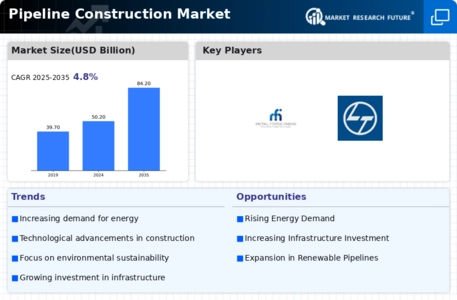Pipeline Construction Size
Pipeline Construction Market Growth Projections and Opportunities
The Pipeline Construction market is influenced by several key factors that play a pivotal role in its growth and development. To gain insights into the dynamics of this industry, it's essential to explore the critical market factors shaping the Pipeline Construction market. Here are the key factors presented in a clear and concise pointer format: Energy Demand and Infrastructure Development: The demand for energy resources, including oil and natural gas, drives the need for pipeline construction. As global energy consumption continues to rise, there is an increasing requirement for efficient transportation infrastructure to move these resources from production areas to consumption centers. Expansion of Oil and Gas Exploration: The growth of pipeline construction is closely tied to the expansion of oil and gas exploration activities. As new oil and gas reserves are discovered, the need for pipelines to transport these resources becomes paramount, boosting the pipeline construction market. Renewable Energy Transition: The shift towards renewable energy sources, such as wind and solar, also influences the pipeline construction market. Pipelines are essential for transporting materials like hydrogen or biofuels, supporting the evolving energy landscape as countries aim to reduce their reliance on traditional fossil fuels. Government Policies and Regulations: Regulatory frameworks and government policies have a significant impact on the pipeline construction market. Environmental regulations, safety standards, and energy policies shape the conditions under which pipeline projects are planned, approved, and executed, impacting the overall market dynamics. Global Economic Trends: Economic conditions on a global scale influence investment decisions in energy infrastructure, including pipelines. Economic stability, access to financing, and overall investment climate play a role in determining the pace and scale of pipeline construction projects. Technological Advancements in Pipeline Construction: Innovations in pipeline construction technologies enhance efficiency, safety, and environmental sustainability. The adoption of advanced construction methods, monitoring systems, and materials contributes to the overall growth and competitiveness of the pipeline construction market. Environmental and Social Concerns: Public and environmental concerns surrounding pipeline projects impact regulatory approvals and project timelines. Issues related to land use, water resources, and community engagement can influence the feasibility and acceptance of pipeline construction initiatives. Geopolitical Factors: Geopolitical considerations, including international relations, trade agreements, and geopolitical stability, influence the development of cross-border pipeline projects. Political events and diplomatic relations between countries can affect the planning and execution of such projects. Natural Disasters and Climate Change Risks: Pipeline construction is vulnerable to natural disasters and climate change risks. Companies operating in this market must consider factors such as seismic activity, extreme weather events, and changing climate patterns when planning and constructing pipelines to ensure resilience and reliability. Investment in Upgrading Existing Infrastructure: The need to upgrade and modernize existing pipeline infrastructure is a significant factor influencing the market. Aging pipelines require maintenance, repairs, and in some cases, replacement with newer technologies to ensure the continued safe and efficient transportation of energy resources.







Leave a Comment